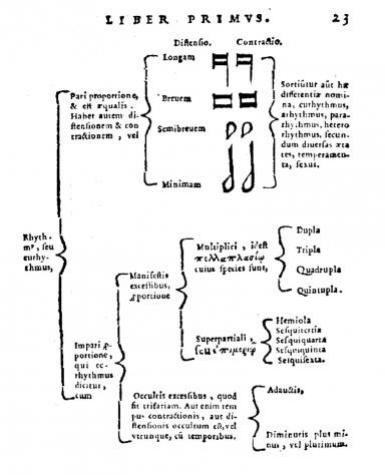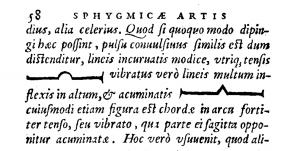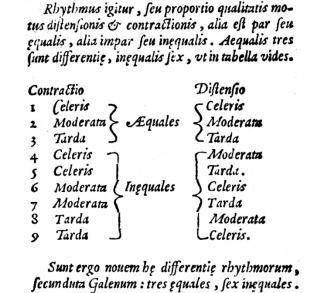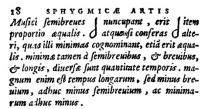Medicine and some of its discipline-sisters as anatomy and physiology have been instrumental in the history of rhythm in Modern Times. Along with music, which will be only briefly touched upon because it would necessitate a complete essay and also because it exists already a good number of studies on the subject, they have transmitted and spread its Platonic and Aristotelian definition. Since métron – measure was the core of the Platonic definition of rhythm, I entitled this section “The Spread of Metron.” But, medicine, anatomy and physiology have also been witness of a complex semantic history during which a bunch of new meanings have been added to the original concept, while older ones disappeared. This is the intricate history with which I would like to begin our journey.
Matching Pulse and Cosmic Cycles – Rhythm as Ratio (6th cent. – early 17th cent.)
As we saw in the previous volume, after Galen’s ambitious theoretical synthesis in the 2nd century AD, which was, in the main, still faithful to Herophilus’ pulse lore (3rd cent. BC) (chap. 4), there was a deep shift in the medical and physiological definition of rhythm during the 3rd and the 4th centuries AD (chap. 7).
Under the influence of a strong neo-Platonic trend that submerged the last period of the Roman Empire, the concept of rhythm, which originally had been transferred from poetry, music and dance theory into medicine, undoubtedly under its Platonic and Aristotelian guise but out of sheer methodological and practical concern, was fully essentialized and naturalized. Whereas it was meant to help assessing as correctly as possible the varying diagnostic quality of the pulse, it was now increasingly considered as existing per se.
In Boethius’ De institutione musica (ca. 480-524 AD), which remained a regular academic textbook throughout the Middle Ages, the rhythms of the body were directly related with those of the cosmos. The human microcosm was emulating the rhythms of the macrocosm. Thus rhythm, which had been considered by Herophilus and still by Galen as varying proportion between time-lengths, began to imply a succession of cycles and return of the same and be subjected to the concept of harmony (chap. 9).
We should be careful not to conflate all medieval opinions concerning the pulse since there is evidence of some physicians’ strong empiricism and disbelief concerning its so-called “musicality.” Nancy Siraisi cites, for instance, Ibn Rushd – Averroes (1123-1198) and, in the West, Gentile da Foligno (d. 1348) as expressing a certain skepticism concerning the music of pulse (1975, respectively p. 700 and 692). This is something that remains to be studied in detail. However, it seems that in the West as well as the Islamic world with Ibn Sina – Avicenna (980-1037), the Idealist belief that music was inherent in the beating of the pulse was widely shared throughout the Middle Ages (Siraisi, 1975, p. 689).
This opinion was naturally held by music theorists, encyclopedists, natural philosophers, and even some theologians. Siraisi provides an impressive list of authors who endorsed this view: Aurelian of Réôme (fl. ca. 840-850); Remigius of Auxerre (ca. 841-908); Honorius of Autun (1080-1154); Hugh of St. Victor (ca. 1096-1141); Richard of St. Victor (d. 1173); Jerome of Moravia (d. af. 1271); Bartholomeus Anglicus (ca. 1203-1272); Iacobus de Ispania (d. af. 1330) (1975, p. 689, n. 1).
But, at least from the 13th century to the 16th century, it was also supported by many physicians and medical writers who appropriated previous suggestions exposed by Avicenna in his famous Canon which had been translated into Latin by Gerard of Cremona during the second half of the 12th century. In Northern Italy, the “music of pulse” was widely discussed among physicians and university professors of medicine who set up “a fairly continuous tradition” (Siraisi, 1975, p. 689).
Pietro d’Abano (ca. 1257-1316) was the first of a long series of medieval Italian physicians to put emphasis on this theme. He paid particular heed to the Idealist definitions of music elaborated in the late Antiquity by authors such as Augustine (354-430 AD), Boethius (ca. 480-524 AD) and Isidore of Seville (ca. 560-636 AD) (see vol. 1, chap. 9). He claimed, following Avicenna, that the proportions between durations were distributed according a fixed mathematical and musical progressive scale: (2/1), (3/2), (4/3), (5/4) and (5/2). He strengthened the idealization of the concept of rhythm, which had already partly integrated the meaning of return, repetition, by subjecting it further to the concept of harmony. Finally, coming back to Boethius’ Idealist view, he strongly emphasized the relation between the musica humana and the musica mundana, making the pulse rhythm a direct replica of the cosmos rhythm.
To tell the truth, Siraisi notices a tendency among the Italian physicians of the 14th and 15th centuries to reduce “the music of pulse” to a mere technical comparison aiming at interpreting it as a mere sign of the state of the body. However, none of them seems to have been able to overthrow the neo-Platonic beliefs which structured their mental framework and to adopt a plain empiricist viewpoint.
Ultimately, theirs criticisms were practical and derived from experience, being based on common-sense conclusions about music and pulse. Yet they were unwilling to abandon an established branch of theoria solely on account of practical considerations. Thus, although modified, the musicality of pulse, a concept with decidedly neo-Platonic overtones, continued to be asserted by physicians trained in Aristotelian natural philosophy. (Siraisi, 1975, p. 709)
Although both Galen’s medical doctrine and Boethius’ neo-Platonic philosophy began to be severely criticized in the 16th century, the link between pulse rhythm, music rhythm and cosmos rhythm remained a medical cliché at least until the early 17th century.
It still marred the first use since Herophilus of a clock for timing the pulse made by Johannes Kepler (1571-1630), the astronomer, at the beginning of the 17th century. Unlike his predecessor who, in the 3rd century BC, employed a water clock (see vol. 1, chap. 4), Kepler used a modern clock driven by a falling weight and found a pulse rate of 70 per minute common. However, he thought that it “should” be 60—one per second—in a mystical relationship with the movements of the heavenly bodies (Fleming, 1997, p. 17).
Do the sections of equinoctial hours match the human pulse?
In the vigorous, robust, and mature man, of melancholic temperament or growing old, almost every second there occurs one pulsation of the arteries [fere singulis secundis existunt singuli pulsus Arteriae], without any distinction being made between systole and diastole, that is sixty pulsations in one minute. It is rarely slower; usually it is 70 [vulgariter numerantur 70]; in bilious temperaments and women it is 80, four in every three seconds. In short, there is more or less four thousand pulsations in one hour. (Johannes Kepler, Epitomes Astronomiae Copernicanae, Linz, 1618, 1.3.3, GW, vol. 7, p. 180, my trans.)
Although Kepler discovered the laws of planetary motion which provided one of the foundations for Isaac Newton’s theory of universal gravitation, empirical evidence was not yet strong enough to balance his belief in a mystical link between pulse and cosmic rhythm. Consequently, the new sense of beat, measure and frequency, which was soon to become a dominant aspect of the rhythm concept in medicine, was still enveloped in the older sense of ratio, periodicity and cosmic revolutions.
Noting the Pulse – Rhythm as Ratio (Struthius and Mercado – 1540-1584)
The medical belief in the music of pulse and its astrological correlates, which incited to conflate the concept of rhythm with that of period or cycle, had a late Scholastic counterpart which transformed the notion of ratio itself.
This trend was illustrated in the 16th century by two authors: the Polish physician Josephus Struthius – Józef Struś (1510-ca. 1569) who published in 1540 Sphygmicae artis iam mille ducentos annos perditae et desideratae which was reprinted many times (I used the 1573 edition); and the Spanish physician Luis de Mercado’s (ca. 1525-1611) who published in 1584 De pulsus arte et harmonia – On the Art of Pulse and Harmony, which I will not comment since it heavily borrowed from Struthius’ work and did not add anything new to it (for a presentation see Pennuto, 2017).
Struthius was professor of medicine in Padua (1535–1537) and personal doctor of Polish kings. He also served as mayor of Poznań. De Mercado was protomédico general to the Kings of Spain and Portugal Philip II et Philip III, and professor at the university of Valladolid.
Struthius, was extremely conservative in his thinking as well as in his medical practice. In his treatise, he referred mainly to Galen’s teaching (see vol. 1, chap 7). The main differentiae in the human pulse were its quantity, speed, frequency, and strength, the quality of the arteries (cf. table p. 8), and the order or disorder in the succession of pulsations (p. 12-13). Concerning the concept of rhythm used by the physicians, he attributed its origin to music and not poetry—he did not mention the possibility that it may have been common to both because music and poetry were not originally dissociated.
The word rhythm is used in music, from which it has been transferred by physicians. But Pliny pretends that it derives from poetry and was termed in medicine after the metric laws. However, it usually means harmony, concord, number, skillful connection, modulation [consonantiam, concentum, numerum, concinitatem, modulum]. (Sphygmicae artis, 1573, p. 14-15, my trans.)
Modulus (small measure) and numerus recalled the Roman tradition (see vol. 1, chap. 6 sq.). Consonantia, concentus and concinnitas seemed instead more recent and borrowed from the new musical practices that developed from the 14th century with the polyphonic music called ars nova—in which ars was to be understood as “skillful “technique” of associating sounds harmoniously as much as rhythmically.
Struthius strongly stressed the difference between music and medicine in which the rhythm was defined as “proportion between alternate times,” i.e. between the temporal quantity, i.e. duration of the dilation and the contraction of the arteries.
[In medicine] the correct definition of rhythm is [...] the proportion between the alternate times that make up the pulse [eorum quae in pulsu sunt temporum ad invicem proportio]. Proportion, according to Euclid, is the relation [habitudo] between one quantity with another of the same kind: because time belongs to the genus of quantity, [the physician] compares the quantity of the first time [the dilation] [quatitatem unius temporis] to that of the second [the contraction] [ad quantitatem alterius], to look if they are equal or if one of them exceeds the other. (Sphygmicae artis, 1573, p. 15, my trans.)
The most innovative part in Struthius’ work concerned the measure of rhythm. In opposition to Galen’s prejudice against the use of musical notation, he advocated the use of the contemporary musical mensural notation, which in this instance greatly enhanced the ancient metric notation.
Not only the alternation of dilation and contraction was comparable to that of “arsis seu elevatio” (upbeat) and “thesis seu positio” (downbeat), but it was possible to record their respective duration with musical note symbols like longa – quadruple whole note, brevis – double whole note, semibrevis – whole note, and minima – half note (p. 17-18).

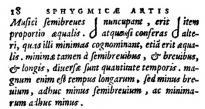
The pulse rhythm naturally varied according to temperament, gender, age, season, and place. The pulse of infant, for instance, was composed of two successive minimae (half notes: relative duration = 1/2), i.e. ½/½; that of young people of two semibreves (whole notes: relative duration = 1), i.e. 1/1: that of adults of two breves (double whole notes: relative duration = 2), i.e. 2/2; that of the elderly of two longa (quadruple whole notes: relative duration = 4), i.e. 4/4 (p. 18).
The pulse rhythm was a meaningful sign of health and illness (p. 18). As long as the rhythm remained “equal” (aequalis), i.e. a fraction equal to 1, the patient enjoyed a “harmonious and ‘skillfully connected’ rhythm” (consonus et concinnus), a eurhythmus, which was its rhythm of health (p. 19). But whenever, “because of an illness or for another reason,” his rhythm took a slower or faster pace, he could feel his health deteriorate. His pulse rhythm would become a pararhythmus, a rhythm close but not exactly corresponding to his age. For instance, in old people the pulse, which was normally composed of two longas (4/4) could become two breves (2/2). If the change brought the patient to a two minimae rhythm, typical of childhood (½/½), i.e. if the pulse quadrupled its frequency, his/her health was greatly in danger: for the elderly, it was indeed a heterorhythmus, a rhythm foreign to their age. Finally, if the rhythm became uneven and, in particular, composed of a brevis and a minima (2/½ = 4/1), or a semibrevis and a minima (1/½ = 2/1), the elderly was in the ecrhythmus, a rhythm which “did not belong to any age” (p. 19-20 – for the corresponding Galenic classification, see vol. 1, p. 282-284).
This seemed at first to be a simple translation into the new mensural notation from the old metric notation proposed by Herophilus in the 3rd century BC and recapitulated by the pseudo-Rufus in the 2nd century AD (see vol. 1, p. 156). But there were some noticeable differences with the Ancients’ theory.
First, it implicated a different view of the life cycle. Whereas the Ancients observed a pyrrhic pulse (diastole/systole) in infancy (◡ ◡ : 1/1); a trochaic pulse in growing children and adolescents (– ◡ : 2/1); a spondaic pulse in adults (– –: 2/2); and a iambic pulse in old people (◡ –: 1/2), i.e. as a solar curve rising in the prime of life then falling down during old age, Struthius thought that the pulse was continuously enlarging and slowing down from ½/½ to 4/4, although he noticed, as his predecessors, that in elderly “the contraction could be longer and the dilation shorter” (p. 18).
The second difference was more important. Since they were using the metric poetic system, the ancient physicians had at their disposal a quite limited notation tool that allowed to note only four proportions based on 1 (◡ ) and 2 times (◡ ◡ or –). The new musical notation was much more versatile and precise since it allowed to combine four different kinds of time-lengths: minima (½ time); semibrevis (1 time); brevis (2 times); longa (4 times), making up at least 64 possible rhythms.
Last but not least, Struthius suggested to make the rhythm classification simultaneously empirically easier to use and closer to the Scholastic standard of rationality by basing it on a rigorous dualistic system. Instead of using only a scale graduated with increasing degrees of deviation measured against a eurhythmic norm, he proposed to develop a full rhythmic system, first by differentiating two branches grouping equal and unequal rhythms (aequalis/inaequalis rhythmus or pari/impari proportione), i.e. eurhythmus or ecrhythmus (“ecrhythmus sive inaequalis rhythmus” – p. 21), and by growing from those primary branches subsidiary branches based on opposite series of musical proportions.
Equal rhythms had dilation and contraction of equal durations, be they—“depending on age, region, temperament, and sex”—longam/quadruple whole note, breuem/double whole note, semibreuem/whole note, or minimam/half note (4/4, 2/2, 1/1, ½/½).
Unequal rhythms had unequal dilation and contraction, according to multiplex proportions, i.e. when a number contained an inferior number a certain number of times (1/2; 1/3; 1/4; 1/5 or 2/4; 2/6; 2/8; 2/10; etc. ); superpartialis proportions, i.e. when a number contained an inferior number and its half or its third or its fourth, and so on (3/2; 4/3; 5/4; 6/5; etc. called proportio sesquialtera; sesquitertia; sesquiquarta; sesquiquinta, etc. ); or even occulta proportions in which “either the time of contraction or that of dilation was hidden.”
In a typical scholastic manner, multiplying branches like the ornamentation of a Flamboyant cathedral, as Panofsky once put it for a previous period, Struthius added that there could be also “composite proportions (compositas proportiones) made of multiplex and superpartialis, or multiplex and superpartientis.” The superpartientis proportion was defined as the opposite of the superpartialis, i.e. the proportion between a number and another number containing the first one and several aliquot parts of it (2/3; 3/4; 4/5; 5/6; etc.). He summarized his view in a arboreal graph (see in Sphygmicae artis, 1573, p. 23).
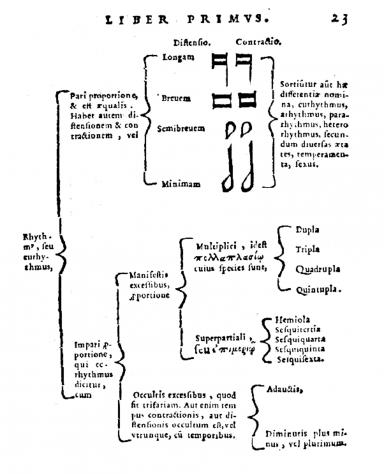
Struthius added one more degree of complexity to his scholastic conceptual proliferating system by finally integrating in it a suggestion once made by Galen, in a quite different spirit as a matter of fact since it aimed at introducing ratios of varying proportions and certainly not at multiplying binary classifications (see vol. 1, p. 288). He proposed to differentiate both original branches of equal and unequal rhythms (rhythmi aequales/inaequales) not only according the ratio between the durations of dilation and contraction, but according to their respective speed (Sphygmicae artis, 1573, p. 26).
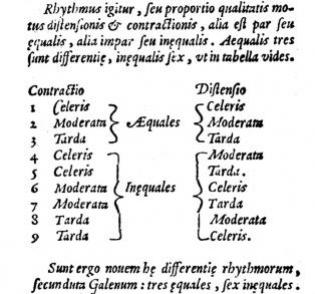
Struthius’ rhythm theory was based on the typical medieval idea that Man was determined by series of numbers but he developed it according to the Scholastic method that was still in use in his Flamboyant time. The whole life of the human being was covered by a universal tree classifying rhythmic ratios, which decided between health and pathological state. In short, Struthius’ Galenism was a cross between Boethiusian numerology and Scholastic logic.
However, although having a foot firmly planted in the past, Struthius heralded an important rhythmological change. While still being closely related to the periodic return of the heavenly bodies, and part of a dualistic Scholastic system, the concept of rhythm was now associated with a more precise measure of time. As a matter of fact, Struthius’ treatise included the first attempt ever made at the graphic representation of the form of the pulse derived from the feeling of the fingers on a superficial artery.
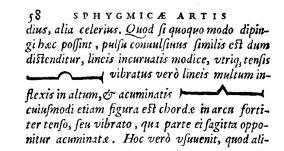
Mechanizing the Pulse – Rhythm as Ratio (Harvey – 1610-1628)
With his Exercitatio Anatomica de Motu Cordis et Sanguinis in Animalibus – An Anatomical Exercise on the Motion of the Heart and Blood in Living Beings, published in 1628 but which summarized studies probably started in 1610, William Harvey (1578-1657) definitively outdated Galen’s physiological system.
For the sake of clarity, we must here enter into some details concerning the physiological theory of the time. Galen held that the blood flowed through two vascular systems, communicating through the septum of the heart (the wall between the left and right side of the heart), from heart and liver to all parts of the body where it was finally consumed. According to this system, that was considered authoritative throughout the Middle Ages and still late into the 17th century, venous impure blood was first created in the liver from chyle coming from the intestines, imbued with the first vital form of pneuma allowing energy and growth, and transferred by the veins to the right ventricle of the heart. Arterial blood was then created by the purification of the venous blood whose impurities were exhaled through the lungs, then by the tricking through invisible “pores” or “channels” in the interventricular septum to the left ventricle. There, the blood was imbued with a higher spirited form of pneuma, drawn from the outside via the pulmonary artery by inhalation through the lungs. This blood, along with its associated vital pneuma, went via the arteries issuing from the heart to the brain. There the blood was further refined and charged with the final and highest form of psychic pneuma, which by passing through the ventricles of the brain to the nerves allowed thought and movement.
Although Galenic medicine correctly distinguished between veins and arteries, and used the observation and characterization of the pulse variations as an efficient diagnostic technique, it could not correctly explain the general concepts of the pulse generation. It was believed that both the heart and the arteries had their own pulsation and that they contracted simultaneously. The arterial pulse was the result of an active force generated in the arterial surface.
Instead of this complex system, Harvey established that the arteries and veins contain nothing but blood, that the blood constantly circulates in the body under the action of the heart, which functions as a pump, through two separate circuits: the lesser “circulation”—our “pulmonary circulation”—that flows from the right ventricle of the heart through the pulmonary arteries to the lungs and then returns to the left atrium of the heart through the pulmonary veins, and the “greater circulation—our “systemic circulation”—that flows from the left ventricle to the extremities via other arteries and from extremities back to the right atrium via the venous system.
Consequently, Harvey found that the heart beat was the result of the simultaneous contractions of the two auricles followed by those of the two ventricles, as long as the animal or the human being was alive. The source of the arterial pulse was in turn generated by the contraction of the left ventricle and consisted in a discontinuous and passive dilation of the arteries caused by the blood inflow. Harvey compared this dilation to the process of inflating a glove by blowing air into it. This image meant that dilation was not the result of a mere return to normal following a contraction of the heart or the arteries, or even a positive motion due to a certain dynamism proper to them, as it had been believed for centuries. It was more like the result of an increased pressure in a pipe. But it meant also that, in Harvey’s opinion, if the heart and the arteries pulsated alternatively, the contraction of the heart prompting the dilation of the arteries, the pulse nevertheless was synchronous in the heart and the arteries—Ernst Heinrich Weber (1795-1878) discovered the delay in the transmission only in 1827.
Contrary to the usual teaching, it is clear from the facts, that the diastole of the arteries corresponds to the systole of the heart, and that the arteries are filled and distended by the blood forced into them by the contraction of the ventricles. The arteries are distended because they are filled like sacs, not because they expand like bellows. All the arteries of the body pulsate [pulsant] because of the same cause, the contraction of the left ventricle. Likewise the pulmonary artery pulsates. To illustrate how the beat in the arteries is due [arteriarum pulsu fieri] to the impulse of blood [ab impulsu sanguinis] from the left ventricle, one may blow into a glove, distending all the fingers at one and the same time, like the pulse [pulsum]. (Harvey, De motu cordis et sanguinis, 3, p. 47, trans. Chauncey D. Leake)
However, this radical shift in perspective had no direct impact on the concept of rhythm. Harvey used it to denote the alternating motions of the heart, which was a novelty compared to its traditional use qualifying the proportion between the motions of the arteries, but he did not change its definition. As it was customary in his time, he complemented rhythm with harmony, i.e. ratio based on perfect number. The motions of the auricles and the ventricles, he said, “take place consecutively but in such a manner that there is a kind of harmony and rhythm preserved between them.”
The motion of the heart is as follows: First, the auricle contracts, and this forces the abundant blood it contains as the cistern and reservoir of the veins, into the ventricle. This being filled, the heart raises itself, makes its fibers tense, contracts, and beats [omnes nervos tendit, contrahit ventriculos & pulsum facit]. By this beat [quo pulsu] it at once ejects into the arteries the blood received from the auricle; the right ventricle sending its blood to the lungs through the vessel called the vena arteriosa, but which in structure and function is an artery; the left ventricle sending its blood to the aorta, and to the rest of the body through the arteries. These two motions, one of the auricles, the other of the ventricles, [take place consecutively, but in such a manner that there is a kind of harmony and rhythm preserved between them] [seruata quasi harmonia & Rhythmo], so that only one movement may be apparent, especially in warm-blooded animals where it happens rapidly. (Harvey, De motu cordis et sanguinis, 5, p. 47, trans. Chauncey D. Leake, my mod.)
A little further down, Harvey faithfully endorsed Galen’s categories concerning the pulse and, by the same token, his definition of rhythm: size, strength, speed, rhythm—ratio between systole and diastole—fullness, and regularity. The only difference was the new place he gave to frequency which was quite secondary to Galen and became, in his list, the third differentia (for Galen’s list see vol. 1, p. 286).
The pulse corresponds to the tension of the heart [secundum cordis tentionem pariter pulsus] [in size, strength, frequency, speed, while still preserving rhythm, fullness, and regularity] [siunt maiores, vehementiores, frequentes, celeres, rythmum, & quantitatem, & ordinem feruantes]. Because of the motion of the blood it is reasonable to expect the heart beat and the dilatation of the arteries, even the more distant ones, to go together. It is like inflating a glove or bladder, or like in a drum or long beam, when the stroke and beat occur together, even at the extremities. (Harvey, De motu cordis et sanguinis, 3, p. 48, trans. Chauncey D. Leake, my mod.)
In the end, the main novelty was, ironically, the recess of the physiologist consideration for the rhythm issue itself, at least as it was defined at that time, which was alluded to only twice in the whole treatise. Clearly, Harvey was less interested in semiology than in anatomy. What counted most now was the circulation of blood in the “lesser” as well as the “greater” circulation. Therefore the pulse was still present in his mind, however it was not taken as a sign of the patient’s state of health but in a mere mechanical and physical way: the alternation of the movements of a pump.
To support his view, he used in chapter 9 quantitative arguments. He measured the average weight of blood (and therefore volume) that can be pumped from the heart with each beat—in humans that was about two ounces, sometimes three—measured according to the Apothecaries or Troy weight that was in general use in Europe. He then estimated that if there were 2000 beats per half hour (66 beats/mn) the heart would pump and bring to the periphery 2000 beats x 2 oz. x 2 = 8000 oz. in an hour, or about 666 pounds of blood. Harvey deduced that such an amount of blood could not be produced or consumed in one hour; therefore, it had to circulate out in the arteries and back in the veins, over and over again, as long as the human was alive. This explains why not rhythm as ratio between dilation and contraction of the arteries but volume and frequency of the pulse beat were now at the center of Harvey’s attention.
Thus, Harvey’s personal direct contribution to rhythmology must not be overrated. It took some time before his discovery and the mechanical spirit it implied really changed the concept of rhythm. In spite of his own extraordinary discoveries, Harvey was actually remarkably conservative. In De generatione animalium – On Animal generation (1651), he explicitly rejected atomism and materialism. The works of nature, he claimed, contained “consummate art, and providence, and wisdom.” They had been constructed “for a certain purpose, and to some good and [...] by the Divine Architect” (quoted by Deming, 2012, p. 110). He was a devoted Christian and firmly believed in Aristotelian teleology. Nature did “nothing in vain,” and God had constructed the human body with a purposeful and intelligent design.
Then I reflected on the symmetry and size of the vessels entering and leaving the ventricles of the heart, for Nature, making nothing in vain, would not have given these vessels such relative greatness uselessly. (Harvey, De motu cordis et sanguinis, 8, p. 69-70, trans. Chauncey D. Leake)
Copernicus (1473-1543), Kepler (1571-1630) and Galileo (1564-1642) had overthrown the Ptolemical theory of the circular motion of the stars in the heavenly spheres, but Harvey seemed never to have heard of their discoveries. His inspiration for proposing circulation of the blood was the ancient Greek idea of circular motion as perfect. In On Generation and Corruption, Aristotle had written that “circular motion [...] is the only motion which is continuous” (2.10, 337a, trans. Harold H. Joachim). And Aristotle’s conception of circular motion in turn was influenced by the earlier Pythagorean conception of circular motion as perfect (Deming, 2012, p. 110).
Harvey was also influenced by the astrological doctrine, which was most common in the Renaissance, of the mystical relationship between Macrocosm and Microcosm. The motion of blood was circular as the cycle of “air and rain” or the “circular motion of the superior bodies.”
[I surveyed my mass of evidence derived from vivisections] [...] [and] I began to think there was a sort of motion as in a circle. [...] This motion may be called circular in the way Aristotle says air and rain emulate the circular motion of the superior bodies. (Harvey, De motu cordis et sanguinis, 8, p. 70, trans. Chauncey D. Leake, my mod.)
Then invoking the traditional analogy between Macrocosm and Microcosm, he concluded that “the heart is the center of life, the sun of the Microcosm, as the sun itself might be called the heart of the world.”
The moist earth warmed by the sun gives off vapors, which, rising, are condensed to fall again moistening the earth. By this means things grow. So also tempests and meteors originate by a circular approach and recession of the sun. Thus it happens in the body by the movement of the blood, all parts are fed and warmed by the more perfect, more spirituous, hotter, and, I might say, more nutritive blood. But in these parts this blood is cooled, thickened, and loses its power, so that it returns to its source, the heart, the inner temple of the body, to recover its virtue. Here it regains its natural heat and fluidity, its power and vitality, and filled with spirits, is distributed again. All this depends on the motion and beat of the heart. So the heart is the center of life, the sun of the Microcosm, as the sun itself might be called the heart of the world. The blood is moved, invigorated, and kept from decaying by the power and pulse of the heart. It is that intimate shrine whose function is the nourishing and warming of the whole body, the basis and source of all life. (Harvey, De motu cordis et sanguinis, 8, p. 71, trans. Chauncey D. Leake)
Thus Harvey did not directly transform the concept of rhythm, which he maintained exactly as he found it in Galen, but he diminished its importance for medicine, while preparing two opposite mutations: on the one hand, in a mechanistic spirit, he introduced beat and frequency as subject of concern; on the other hand, he passed on the age-old comparison of the body movements with the natural periods or cycles.
Counting the Pulse – Towards Rhythm as Beat (Santorio and Galileo – 1602-1625)
Until recently, it was commonly believed that in his early years in Pisa, while studying medicine, Galileo (1564-1642) had invented an instrument, based on his discovery of the isochronicity of the pendulum swing, to allow the exact record of the pulse frequency (for this section, I used partly Bigotti, Taylor, Welsman, 2017).
New research has convincingly shown that this opinion was utterly mistaken and that the first technological application of the pendulum is due to Santorio Santori (1561-1636), who created what he called the Pulsilogium [lit. instrument that measures the pulse], possibly between 1590 and 1602, when the first mention of this new device was made in a treatise De pulsibus written by a colleague of Santorio in Padua. Santorio presented himself his invention in 1603 and in a more extended fashion—interestingly, given the role of Avicenna in the pulse theory in the Middle Ages—in his Commentaria in primam Fen primi libri Canonis Avicennae – Commentary to the Canon of Avicenna, published in Venice in 1625. According to the newest findings, “it probably constituted a source of inspiration for, rather than being an invention by Galileo, and sparked an entire path of experiments in 17th century” (Bigotti, Taylor, Welsman, 2017, p. 30).
The Pulsilogium, in its simplest form, consisted of a weight—most probably a musket ball—swinging on the end of a cord; the rate of the swing was synchronized with the pulse by altering the length of the cord and, from this length, the rate of the pulse could be determined and compared with previous measures. As in Herophilus and Galen, the pulse of a patient could be compared to his or her own previous pulses and also to the pulse considered normal in his or her age group, gender, temperament.
The Pulsilogium [was] intended to measure “the quantity” or “the degree of distance” [quantitas/gradus recessus dimetiri] of the pulse rate, that is to say its variation in healthy or unhealthy conditions. Such distance [recessus] spans from a minimum to a maximum of frequency as well as intensity which, in reference to the latter, Santorio—and all Renaissance physicians—called “range of health” [latitudo sanitatis]. The Pulsilogium seems to have been used chiefly as a comparator: Santorio compared different segments of chord related to the increase or decrease of the pulse rate in terms of a rapport between degrees. He adopted the device as especially revealing of the variation of pulse frequency in fevers and other symptoms. [...] Whether by means of the Pulsilogium Santorio pursued an analysis of his patients grouping them by typology (melancholic, bilious, choleric, phlegmatic constitution) remains unclear, yet his constant use of the plural for referring to his subjects (sani/aegri homines) is possibly revealing of such an eventuality. (Bigotti, Taylor, Welsman, 2017, p. 33)
With this kind of light and simple instrument available, the attention of physicians began to shift from the size, speed, strength of the dilation, the proportion between dilation and contraction—which had defined for centuries the “rhythm”— the regularity or irregularity of their succession and the qualities of the arteries, that constituted the core of Galen’s teaching, to a simpler measure: the rate of the artery beat. As a matter of fact, frequency had been taken into account as soon as Herophilus and was also an integral part of Galen’s pulse lore but due to lack of precise timing device, general interest in quantification and possibility to elaborate a diagnostic from a fair number of other criteria, it was only secondary. Now, another course could be taken: due to its quantitative aspect and the new technical possibility to measure it easily, it began to counterbalance the other measures which were mostly qualitative and demanded a long training.
This shift in attention and practice initiated a shift in the meaning of the medical concept of rhythm. Whereas, since Antiquity, the latter had continuously denoted, in a poetic and musical way, the ratio between dilation and contraction of the arteries, it began to mean beat and frequency, number of beats per minute. This mutation resulted concomitantly in a kind of secularization of the meaning that had been superimposed upon the original sense during the Middle Ages. The regulation of motion analogous to the harmony between sounds of different pitches and similar to the circular movements of the celestial bodies could be now considered as a mere repetition of a beat having its own law, its own period or cycle, i.e. being regular.
When a few decades later (1654) Galileo’s disciple Vincenzo Viviani (1622-1703) claimed that his master had invented the Pulsilogium shortly after his famous observation of the chandeliers swing in the Pisan church he was attending, he launched a nice piece of storytelling that we now know to be a legend. But he was capitalizing upon a number of real facts that are of great interest to rhythmology because they emblematize the passage from one era to another.
On the one hand, Galileo’s father was a famous lutenist, composer, and music theorist, and he himself had become an accomplished lutenist and learned early from his musical practice to appreciate periodic or musical measure of time. In 1581, Galileo had embarked on a medical degree at the University of Pisa and he probably had a fair knowledge of the Galenic pulse lore, at least as it was taught in the Italian universities since the end of the Middle Ages in association with the belief in the “music of pulse.” Moreover, as it was usual in a time deprived of portable clock, Galileo had measured the swing of the chandeliers he was fascinated with against his own pulse, therefore considering the pulse as a human clock naturally related with the motion of the heavenly bodies. We know indeed that this was common practice and common belief by the example of Kepler who used to do and think the same during his astronomical observations.
But on the other hand, Galileo’s groundbreaking work on pendulum motion had opened a entirely new scientific perspective that had made possible to overcome the general abstractions and qualitative approach of the medieval “natural philosophy” and substitute it with the empirically tested laws and quantification techniques of the modern “physics.”
Broadly speaking, most of the 16th and 17th century physicians and physiologists remained faithful to the Ancient definition of rhythm. It is obvious in Struthius and Mercado, but even Harvey, although he revolutionized physiology with his discovery of the blood circulation, maintained the old concept. However, the conditions for a significant conceptual shift were already slowly building. As soon as the mid-16th century, Struthius and Mercado had already introduced in medicine a keen interest for timing the pulse. By 1610, whatever the respective role played by Santorio and Galileo in the invention of the Pulsilogium, it was sure that the new earthly and astronomical physics Galileo was helping to develop, along with the spread of its Mechanistic spirit, were bound to emphasize quantification and the concept of law in physiology and medicine, which meant, as far as rhythm was concerned, the progressive substitution of the notions of ratio, harmony, and cosmic period with those of beat, frequency and regularity.


